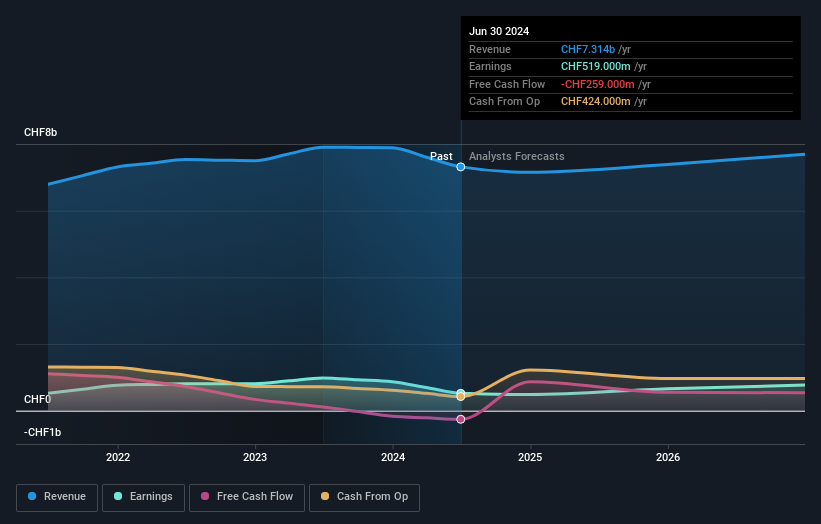- Switzerland
- /
- Luxury
- /
- SWX:UHR
Painful week for individual investors invested in The Swatch Group AG (VTX:UHR) after 5.6% drop, institutions also suffered losses

Key Insights
- Swatch Group's significant individual investors ownership suggests that the key decisions are influenced by shareholders from the larger public
- 49% of the business is held by the top 25 shareholders
- Institutional ownership in Swatch Group is 29%
To get a sense of who is truly in control of The Swatch Group AG (VTX:UHR), it is important to understand the ownership structure of the business. The group holding the most number of shares in the company, around 45% to be precise, is individual investors. In other words, the group stands to gain the most (or lose the most) from their investment into the company.
While institutions who own 29% came under pressure after market cap dropped to CHF8.9b last week,individual investors took the most losses.
Let's delve deeper into each type of owner of Swatch Group, beginning with the chart below.
See our latest analysis for Swatch Group

What Does The Institutional Ownership Tell Us About Swatch Group?
Institutions typically measure themselves against a benchmark when reporting to their own investors, so they often become more enthusiastic about a stock once it's included in a major index. We would expect most companies to have some institutions on the register, especially if they are growing.
As you can see, institutional investors have a fair amount of stake in Swatch Group. This suggests some credibility amongst professional investors. But we can't rely on that fact alone since institutions make bad investments sometimes, just like everyone does. If multiple institutions change their view on a stock at the same time, you could see the share price drop fast. It's therefore worth looking at Swatch Group's earnings history below. Of course, the future is what really matters.

We note that hedge funds don't have a meaningful investment in Swatch Group. Estate of N.G Hayek is currently the company's largest shareholder with 23% of shares outstanding. Meanwhile, the second and third largest shareholders, hold 5.8% and 3.7%, of the shares outstanding, respectively.
Our studies suggest that the top 25 shareholders collectively control less than half of the company's shares, meaning that the company's shares are widely disseminated and there is no dominant shareholder.
While it makes sense to study institutional ownership data for a company, it also makes sense to study analyst sentiments to know which way the wind is blowing. There are plenty of analysts covering the stock, so it might be worth seeing what they are forecasting, too.
Insider Ownership Of Swatch Group
While the precise definition of an insider can be subjective, almost everyone considers board members to be insiders. Company management run the business, but the CEO will answer to the board, even if he or she is a member of it.
Insider ownership is positive when it signals leadership are thinking like the true owners of the company. However, high insider ownership can also give immense power to a small group within the company. This can be negative in some circumstances.
We can report that insiders do own shares in The Swatch Group AG. Insiders own CHF230m worth of shares (at current prices). we sometimes take an interest in whether they have been buying or selling.
General Public Ownership
With a 45% ownership, the general public, mostly comprising of individual investors, have some degree of sway over Swatch Group. While this group can't necessarily call the shots, it can certainly have a real influence on how the company is run.
Private Company Ownership
It seems that Private Companies own 23%, of the Swatch Group stock. It might be worth looking deeper into this. If related parties, such as insiders, have an interest in one of these private companies, that should be disclosed in the annual report. Private companies may also have a strategic interest in the company.
Next Steps:
While it is well worth considering the different groups that own a company, there are other factors that are even more important. Case in point: We've spotted 3 warning signs for Swatch Group you should be aware of.
If you would prefer discover what analysts are predicting in terms of future growth, do not miss this free report on analyst forecasts.
NB: Figures in this article are calculated using data from the last twelve months, which refer to the 12-month period ending on the last date of the month the financial statement is dated. This may not be consistent with full year annual report figures.
New: Manage All Your Stock Portfolios in One Place
We've created the ultimate portfolio companion for stock investors, and it's free.
• Connect an unlimited number of Portfolios and see your total in one currency
• Be alerted to new Warning Signs or Risks via email or mobile
• Track the Fair Value of your stocks
Have feedback on this article? Concerned about the content? Get in touch with us directly. Alternatively, email editorial-team (at) simplywallst.com.
This article by Simply Wall St is general in nature. We provide commentary based on historical data and analyst forecasts only using an unbiased methodology and our articles are not intended to be financial advice. It does not constitute a recommendation to buy or sell any stock, and does not take account of your objectives, or your financial situation. We aim to bring you long-term focused analysis driven by fundamental data. Note that our analysis may not factor in the latest price-sensitive company announcements or qualitative material. Simply Wall St has no position in any stocks mentioned.
About SWX:UHR
Swatch Group
Designs, manufactures, and sells finished watches, jewelry, and watch movements and components worldwide.
Flawless balance sheet and undervalued.


